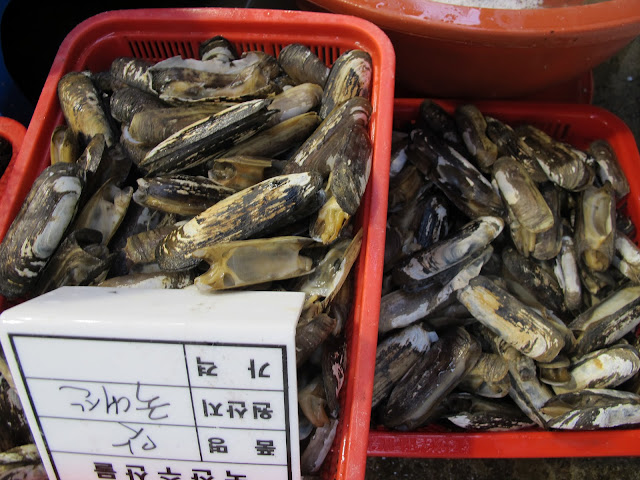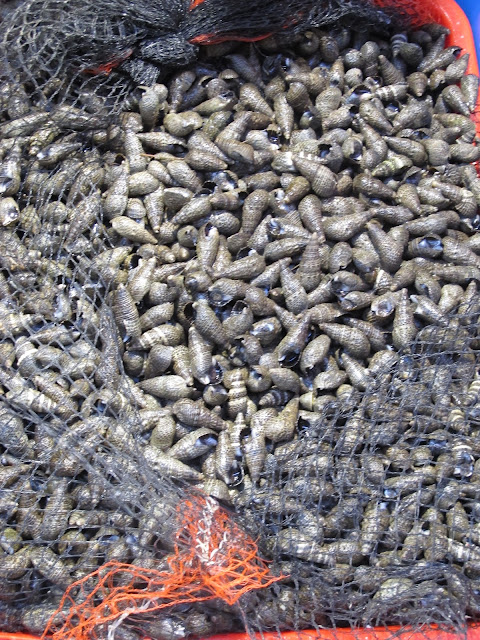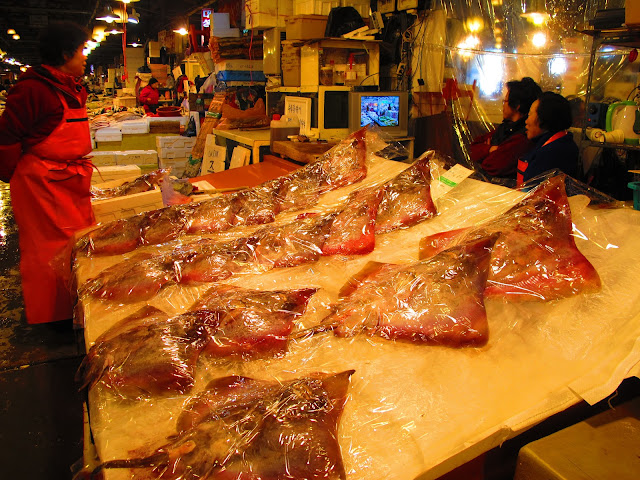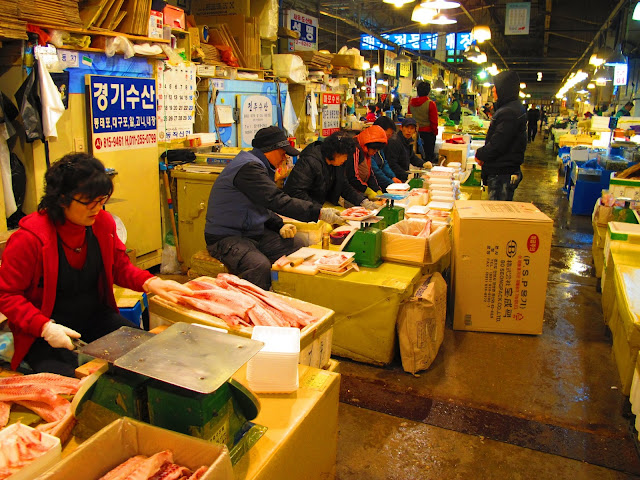
Having finished a series of posts on our adventures in South Korea, I realized I had left out one of the highlights of my trip. This was a solo exploration before the rest of the family was awake. I would meet them at Jamsil Station later in the morning for our outing to Lotte World (see blog post
HERE).
I woke before 5am and quietly made my way out of the room, grabbing a drink and fruit from the 24 hour convenience store downstairs before taking the train from Euijiro-1(il) Ga Station to Noryangjin Station, making a transit along the way. It was surreal coming out onto the cold streets so early in the morning. Except for the road sweeper and the occasional car on the road, there was hardly anyone around. I felt like I had the whole subway to myself. On the other hand, I wouldn't recommend my wife or daughter walking around in the dead of morning alone like this as it could be dangerous.
 |
| I love walking along the empty streets. |
 |
| Feeling like I own the subway. |
 |
| Gorgeous sunrise from inside the train. |
 |
| Subway map showing the proximity of the market area to the station. |
 |
| Arriving at Noryangjin Station with the sunrise. |
 |
| From Noryangjin Station, cross the bridge over the rails and you're there! Alternatively, you can follow the smell. |
The market is divided into three main sections. The first row closest to the railway station sells live seafood, which includes all kinds of fish and critters hanging around in tanks and baskets. The second row focuses on frozen items and raw items that are no longer alive, such as crabs, octopus, and of course, fish. The last row has a variety of semi-processed seafood, such as minced, chopped, packed items. However, these are not cooked and often in its raw state. Behind the market are restaurants that would turn your fresh fish into sashimi for you on the spot. However, these are not as widespread and comfy as the spacious dedicated restaurants at Busan's Jagalchi Fish Market (click
HERE for blog post) If you prefer, you can also head restaurants on the second floor where you can just order off the menu.
 |
| Rows and rows of tanks behind me as a loading truck passed me by on this self-timed shot. |
 |
| Customers bargaining with a shop owner for a good deal. These look like tourists looking for a good fish to turn into sashimi at one of the eateries at the back of the market. |
 |
| Many shops specialize in stuff other than fish, such as live mollusks and other critters. |
 |
| A stall selling live crabs. |
 |
| The 'live section' goes on and on... so much to see, so exciting! |
Previously in my report on Jagalchi Fish Market in Busan (click
HERE for blog post), I had the opportunity to witness the catch come in from the fishing boats. Noryangjin is not near the coast, but receives a variety of products from all over the country. These arrive on the backs of trucks and other vehicles, which explains the hangar sized parking lots for to unload goods early in the morning before the first customers arrive. As a result, observable differences compared to Jagalchi are the wider variety of species here considering they come from all around the country, and the larger proportion of frozen items.
 |
| Football field sized unloading bays. |
 |
| Busy vendors going about their daily routine. The floor is constantly wet here, likely due to the ice used to keep items fresh during the journey. |
I began my exploration at the live section. Obviously, I was looking out for my favourite mollusks. Occassionally, I raided some bags of disposed shells for items to add to my seashell collection. This method of collecting at markets had proved fruitful and fun, uncovering many specimens in great condition without having to pay a single cent. Many shop owners were also happy to help me out by offering me shells that were not broken, chipped. Some went out of their way to clean out or wash the empty shells for me.
Let's start with the bivalves (bi = two. Hence these denote molluscs consisting of 'two sides', otherwise known commonly as 'clams')
 |
| An unidentified species of Venus clam. |
 |
| This larger, meaty species of Venus clam [Saxidomus purpurata (Sowerby, 1852)] was common throughout the markets during our visit to Korea. |
 |
| Large, delicious blood cockles (also known as See-Hum in Singapore, except that these are way larger), likely the popular Anadara broughtonii (Schrenk, 1887) used commonly as food in this region. |
 |
| Pen shells (Family Pinnidae), likely from the genus Atrina. However, I did not get to look at this closely for a possible identification. Large, meaty and tasty! |
 |
| Mussels! [Family Mytilidae] |
 |
| Heart cockles of the family Cardiidae, likely Fulvia mutica (Reeve, 1844). |
 |
| A tellinid clam [Megangulus luteas (Wood, 1828)], not as common compared to the other larger, meatier species but unique none-the-less. |
 |
| A large commonly farmed species of scallop [Patinopecten yessoensis (Jay, 1857)] popular among the Chinese, Japanese, and Koreans! |
 |
| A favourite among seafood lovers! Razor clams [Family Solenidae]. |
 |
| Another smaller species of Venus clam (Dosinia species). |
 |
| Mangrove species of the family Pharidae commonly sold all over markets here [Sinonovacula constricta Lamarck, 1813]. |
 |
| A large delicious and meaty Venus clam species [Callista brevisiphonata (Carpenter, 1864)] commonly harvested as food all along the Chinese, Japanese and Korean coastlines. |
 |
| Freshwater clams, likely a species of Corbicula or Geloina? |
 |
| A stall specializing in clams and molluscs of all sorts! |
Next are the Gastropods. "Gastro" means "stomach" and "pod" means "foot". So literarily, "Gastropod" means "stomach-foot". This refers to the single, flat muscular "foot" used by the snail for locomotion.
 |
| Never really considered moonsnails as good to eat before, but I guess it's accepted as a food here! |
 |
| Buccinids are widely accepted as tasty treats in temperate zones where there are many large, meaty species. Here we find Buccinum verkruzeni Kobelt, 1883, which I had the opportunity to taste at Jagalchi Fish Market earlier in the week! |
 |
| Large turban shells [Turbo cornutus Lightfoot, 1786]. |
 |
| Although this large tasty Rapana venosa was sold everywhere ( I had to try it boiled at Jagalchi), this was a special find. Notice the albinistic specimen on top of the pile? |
 |
| Abalones, abalones all over the place! Likely Haliotis (Nordotis) discus hannai Ino, 1952. |
 |
| The largest buccinid on sale here: Neptunea intersculpta (Sowerby III, 1899). This is the only stall selling this species in the entire market I think. Feel priviledged to chance upon it. The owner spoke Chinese, and introduced himself as a mainlander who came to Korea to import seafood. |
 |
| Buccinum bayani (Jousseaume, 1883). These animals were right at home in the ice box, about the same temperature as the water from which they were trawled a while ago. |
 |
| Uncle sips from his coffee as he awaits his next customer. |
The molluscs were just the tip of the iceberg when it came to counting species sold here. More examples of what you can find for your next steamboat dinner (warning: some of these won't fit in your steam boat, unless you had a bath tub sized one!)
 |
| Tiny creeper snails! |
 |
| Foreground: Salmon and Halibut; background: tanks with live fish! |
 |
| Nice legs! |
 |
| Nice, large legs! Check out the suckers! |
 |
| Sea worms were sold by the bag. I had the opportunity to observe them squirm on the grill as they were cooked alive at Hyundae Beach! |
 |
| Cute fellas: acorn shaped sea cucumbers! |
 |
| Mackerel of all shapes and sizes... a year's supply of Saba fish! Alongside it are tasty Ribbon fish too. Check out the dried version I had at Jagalchi HERE. |
 |
| In Singapore we love our BBQ Stingrays, in Korea they love their dried skates! I heard their meat and texture is similar to stingray. |
 |
| Large crab legs. Imagine how these would taste as you 'suck' out the meat from them after boiling like a straw! |
 |
| Just how large would you like your chili squid? You could wear these squid rings like head-bands. |
The last row of stalls sells processed seafood products. Many of these products appear to be of the 'raw and fresh' kind, not dried or preserve foods you'd find in a typical dry market.
 |
| Vendors here appear to be selling minced up or ground versions of seafood. |
 |
| What's this in the bucket? It doesn't look very appetizing to me. |
 |
| I wonder what these buckets of chum are used for? Looks like a mish mash of discarded fish parts. |
However, the best part about being in Noryangjin wasn't the mountains of seafood, but just being there to soak up the daily life of the vendors that ply their trade day in and day out. I tried to photograph some of the scenes of people going about their daily business to capture some of this essence.
 |
| A messy job, but someone's got to do it. Allows you to appreciate the process by which your seafood comes to your supermarket. |
 |
| This elderly man is turning the skate on the left into plates of neatly carved up sashimi on the right. Such an art-form. |
 |
| Vendors prepare to pack a fish chosen by a buyer by first hacking it to death followed by a bloody gutting. |
 |
| This man is cutting up crabs to be packed into Styrofoam boxes. |
 |
| Vehicles made heavy work easier. |
 |
| It seemed like the packing never ended throughout the frozen food section. |
 |
| Rows of workers carving up frozen halibut fillets. |
 |
| A vendor inspects his tanks by nimbly climbing over them. |
 |
| Stall owners take time out to enjoy breakfast and socialize. I wonder if they're having seafood? |
This would be a place I would love to introduce friends to because of the richness of both Korea's natural heritage and culture on display at the same time. I think children who are willing to get their shoes a little wet would find the tanks here interesting too. I would love to come back, and I'm almost certain that a visit during a different season might reveal different forms of marine-life.
Before I knew it, it was time to make my way to meet the rest of the family at Jamsil station for an afternoon of fun and entertainment at the renowned
Lotte World. The lack of communication made linking up with them after a solo exploration interesting. We had to ensure that we agreed on specific places to meet, and then plan for contingencies should the unforeseen arise. Thankfully, the subways were generally easy to move around in, and we seldom had difficulty finding each other... except for a couple of occasions when we still found each other, albeit much later than expected.



























































Wow! Nice blog. I was searching for such kind of informative blog since a very long time. Really interesting.
ReplyDeleteWelcome to Green Herbz 2014 Potpourri Herbal Spice